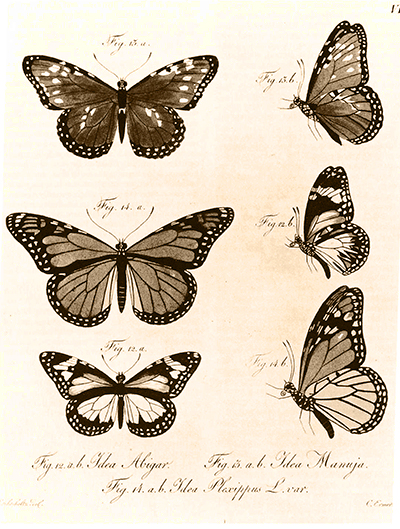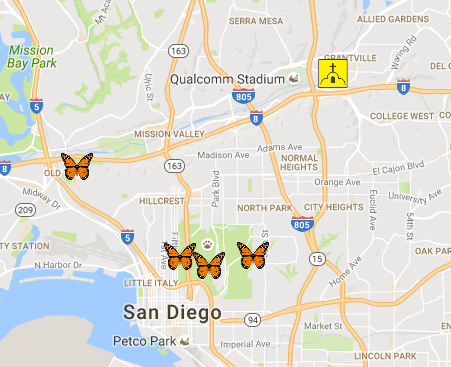It’s October 2016. For a few weeks monarchs have been trickling in from all over the west and aggregating in groves along the California coast to settle in for the winter. Many people have regarded this event as an annual treat, looking forward to the return of the monarchs as surely as the swallows return to San Juan Capistrano (near the Day of San Juan, October 23). For 20 years, researchers and citizen scientists have been documenting overwintering populations of monarchs in California during the Western Monarch Thanksgiving Count. 200 years ago, a different set of observers made the first known documentation of a monarch in California, likely collected from a population overwintering there.
In July of 1815, a Russian expedition of 27 men, including two naturalists and an artist, set out to circumnavigate the globe seeking to find a passage across the Arctic Ocean and recording scientific observations along the way. The expedition made just one landfall in California, near San Francisco in October of 1816 where they met the monarch butterfly, collecting a specimen which became the first documented occurrence of the species in California. While the explorers carefully documented the species – they did not describe the event of collection, so it is unclear as to whether they observed the species overwintering en masse, or happened upon a lone butterfly.

While it may seem a frivolous pursuit to chase down the “first” documentation, we know so little about the history of monarch overwintering habits in the west that any data supporting the phenomenon sheds new insight. Over the last 20 years, observations made during the Western Monarch Thanksgiving Count has produced a data set that has allowed us to make inferences into the population trends of western monarchs, supporting the finding that overwintering monarchs in California have experienced a 74% decline, mirroring that of monarch declines observed in central Mexico.
It’s reasonable, to wonder then – when did the first human observance of the monarch overwintering event occur?
Several native tribes lived along the California coast for centuries and were attentive and thorough observers of the natural world. Surely it would be hard for them to miss large clusters of butterflies hanging from trees in winter, yet unfortunately so little recorded history exists of the native peoples who made coastal California their home before Spanish and European settlers arrived.
The explorer Cabrillo sailed along the California coast in 1542 but hardly made any trips to land. Vizcaíno, the “discoverer” of Monterey Bay was known to have occupied the Monterey peninsula in the winter of 1602–03, yet his party made no mention of collections of bright orange butterflies dangling from the famous Monterey pines present there. The California missions are well-known features of the California coast, with the first being established in San Diego in 1769. Mission San Diego de Alcalá is 8 miles from Balboa Park, where monarchs may be observed overwintering today. Did the missionaries not make the journey, did they not find the phenomenon worth noting, or were the monarchs simply not there at the time?

Moving forward in time, an anonymous author describes in the Monterey Weekly Herald an autumn walk taken in 1873. The author describes “a large, brown species, spotted with black, the only kind known to perch in flocks.” The poetic account goes on to describe “Millions [sic] were fluttering around; while overhead stout branches of firs dropped with their weight; and all twinkling in shade and sunlight, seemed the personification of happiness in their leafy home.” While this is not a scientific account, and the “firs” described likely to be Monterey pines, the story suggests enough to consider it the earliest account describing overwintering masses of monarch butterflies in California.
Another account from 1881, however, implies the phenomenon was known about in the 1860s. Writing in The American Naturalist, Mrs. A. E. Bush, of San Jose, California, noted: “l have been to Monterey, and was fortunate enough to see the ‘butterfly tree’, or trees, as there are three of them. These trees are the Monterey Pine … and completely covered with live butterflies. To say that there were as many butterflies as leaves upon the trees would not be a very great exaggeration. … A lady resident informed me that for the twelve years she has lived there the appearance has been the same.” That would make the first observance in 1869 or earlier.
As John Lane wrote in Overwintering Monarch Butterflies in California: Past and Present (1993):
“Mystery still surrounds the circumstances of the original discovery of overwintering masses of monarch butterflies in California. Somewhere, one expects, there must be a written account of extreme surprise and delighted fascination with the discovery of trees covered with countless multitudes of live butterflies. The further delight in discovering this “lost” account still awaits us.”
Imagine if our trained WMTC volunteers had been following in the footsteps left behind by native peoples, Spanish Conquistadors, and Russian explorers, consistently documenting the population ebbs and flows for 200 years. What might such data reveal? What picture would emerge? When we go out to record the population this year, we are observing a natural phenomenon whose origins may never be known, but by documenting the populations of today—and preserving the resources they need to survive—we can ensure that it will continue, allowing people to delight in the arrival of monarchs for many years to come.



